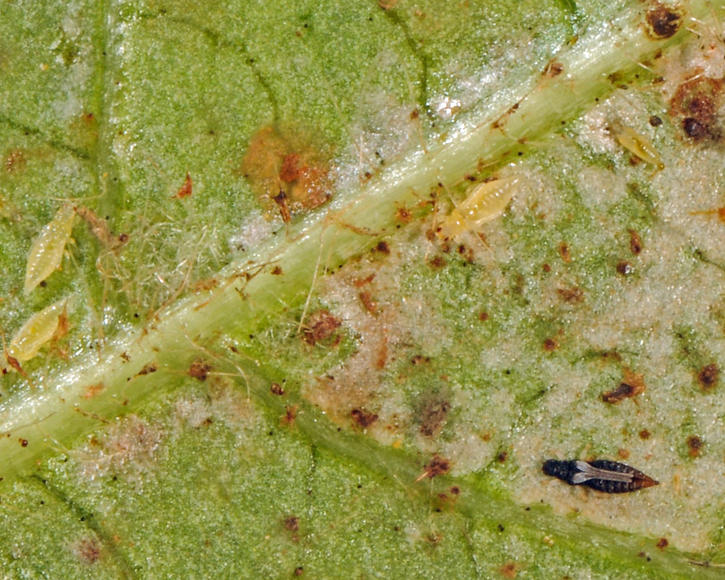Thrips
Thrips are pests that tend to affect houseplants. An infestation results in silvery trails on the upper surface of leaves. We explain how to detect the tiny insects at any early stage and manage them.
Thrips (Thysanoptera) are an order of insects that encompasses around 5,500 species worldwide. They feed on the cell sap of plants, using their distinctive mouthparts to pierce the surface of the leaves. The insects, which are also known as thunder flies, are able to inflate the bladder-like claws at the end of their feet to ensure a better grip on the smooth surfaces of leaves. As the dark brown one to three millimeter long insects are barely visible to the naked eye, infestations are usually discovered quite late.
Only larger clusters of the pests, some of which are winged, and their white to light green larvae can be spotted on the underside of leaves. Their trails are clearly visible by this point: the damaged leaves allow air into the plant cells. Infested areas develop a silvery-white shimmer. Serious infestations of thrips also cause houseplants to suffer impaired growth. Tiny specks of feces and stunted growth quickly expose the pests. Left untreated, a population of thrips can cause significant damage to the host plant, and in severe cases, weaken it so much that it dies.
Houseplants such as Orchids, cordyline, hippeastrum and cyclamen are particularly susceptible to thrips. But passion flowers, rubber plants, flamingo flowers and gloxinia are also often affected. Thrips can also appear on various plants in the greenhouse, such as cucumbers.

Thrips particularly like dry, hot conditions. You should therefore make sure to check your plants for infestations in summer and at the start of the heating season. The small insects are usually found on the underside of houseplant leaves, as their adhesive bladders make it easy for them to stay there. Spray houseplants with lime-free rainwater on a regular basis. You can counteract dry, heated air by placing a container of water close to radiators. Placing pots on wide saucers filled with water also helps to increase the humidity in the vicinity of the plant. Avoid waterlogging at all costs so that houseplants are not weakened any further. Neem oil, which is extracted from the seeds of the Indian Neem tree, is very effective at preventing thrips. Dab the plant’s shoots with a Q-tip that has been dipped in neem oil.
Separate the affected plants before you begin with a specific treatment. This way, you not only prevent the thunder flies from spreading rapidly, but can also better target the infestation. The most effective way of combatting thrips is to spray the isolated houseplant with soapy water. However, you should first cover the upper part of the root ball with saran wrap or a plastic bag to prevent the pests or their larvae from reaching the substrate. Now clean the entire plant with a solution consisting of 0.28 ounces of soft soap and half a liter of water, and repeat the process on a regular basis for several weeks. For larger plants, you should use an emulsion consisting of four tablespoons of olive oil, a small amount of liquid dish soap and two liters of warm water. Spray your houseplants with this mixture every two to three days – the short breaks between treatment prevent the leaf pores from becoming clogged with oil.
Applying a garlic and stinging nettle brew has also proved successful. You’ll need 1.1 pounds of stinging nettles, 0.33 pounds of fresh crushed garlic, and two liters of warm water. Fresh onions can also be used instead of garlic. Mix all of the ingredients together and leave the brew to rest at room temperature overnight. You can then use a watering can to apply the liquid to the affected plants. You should do this several times, leaving a few days between each application. For this treatment too, you should first cover the surface of the root ball.
Neem oil is known for its insecticidal effect. Dab the thrip larvae with a few drops of oil. The active ingredient azadirachtin kills off the thrip larvae by preventing them from molting. To eliminate every generation of the thunder flies, you should use the neem oil together with other control methods.
One way of controlling an infestation is to hang sticky traps. Use a blue trap, since lots of thrips are especially attracted to this color. In contrast, the classic yellow traps are not as popular with the pests. It’s best to attach the sticky traps to a stake and push it into the substrate of the affected or vulnerable plants. As not all thrips have wings, this is a good way to reduce infestations when combined with other control methods.

Thrips can also be controlled indoors using natural predators, such as predatory mites, predatory anthocorids and larvae. The beneficial insects are available online or can be ordered from specialist suppliers at garden centers. Important: if you are using beneficial insects, avoid using any other control measures and make sure that they have optimal living conditions in terms of temperature and humidity.
Important: the substrate at the surface of the root ball should be replaced if the plant has suffered an infestation. Thrip larvae mostly pupate in the soil. If you neglect to do this, a new generation of thrips will develop in the potting soil and the houseplant will become infested again.



